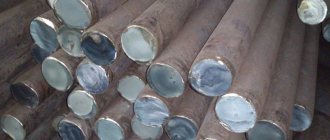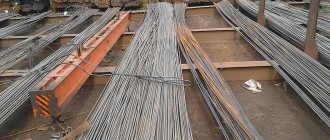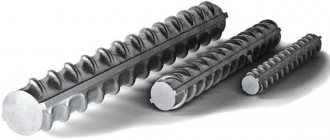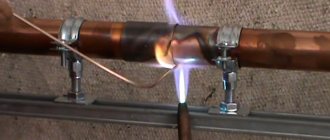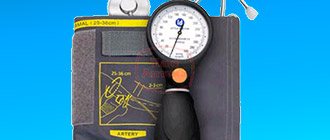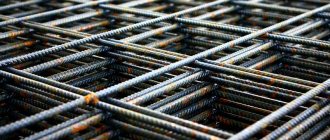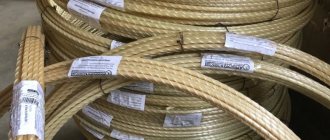What classes are the fittings divided into?
Reinforcing bars are manufactured and marked in accordance with industry state standards. It is marked with a combination of letters and numbers.
It is divided into three main classes:
- A – rod reinforcement intended to form the main frame;
- Вр – wire reinforcement used to connect the main elements together;
- K – rope reinforcement, which is the most important part of factory-made prestressed reinforced concrete parts and structures. It is rarely used in individual construction.
The digital index following the letters can have a value from 1 to 6. The higher it is, the stronger the product. Currently, there is a gradual shift away from the Soviet marking system, so often the same material can be designated in two ways. Table No. 1 is intended to help correlate old and new names.
Table 1. Types of fittings and their names
| Type of fittings | Reinforcement class | |
| Designation | ||
| Old | New | |
| Hot rolled rod (GOST 5781-82*): | ||
| smooth | A-I | A-I(A-240) |
| periodic profile | A-II | A-II(A-300) |
| Ac-II | Ac-II(Ac300) | |
| A-III | A-III(A-400) | |
| A-IV | A-IV(A-600) | |
| A-V | А-V(А-800) | |
| A-VI | A-VI(A-1000) | |
| Thermally strengthened reinforcing steel for reinforced concrete structures Technical specifications GOST 10884-94 | At-IV | At 400s |
| At 500s | ||
| At 600 | ||
| At 600s | ||
| At 600k | ||
| At 800k | ||
| At 1000 | ||
| At 1000k | ||
| Ordinary reinforcing wire: | ||
| smooth | B-I | — |
| periodic profile | Vr-I | — |
The type of reinforcement is determined at the design stage of a reinforced concrete product. In this case, the method of connecting individual elements into a single frame is determined. In practice, electric welding or tying with steel wire intended for this purpose is used for this.
Rod reinforcement – class A
Hot-rolled rod reinforcement is the most popular in monolithic construction. It is divided into classes marked A400, A600 and beyond. When constructing foundations that experience maximum loads, the rods are not subjected to electric welding, but are tied together with wire. In this case, due to some mobility, it is possible to avoid increased local stresses.
Let's consider the main brands of fittings of this class:
AI (A240) – smooth rods with a cross-section from 6 to 40 mm. They are characterized by high plasticity and frost resistance of the resulting monoliths. They can be welded together or tied with wire.
A II (A300) – corrugated rods with a diameter of 10 to 80 mm. They are used as part of prestressed reinforced concrete products. Parts with them as a frame rarely crack even after prolonged use.
A III (A400) - the most common type of reinforcement for high-rise and individual construction has the form of smooth or corrugated rods with a diameter of 6 to 40 mm. Products with the letter “C” in the marking are suitable for welding.
A IV (A600) – used for the frame of prestressed concrete structures. Consist of two steel alloys. They have the form of rods with a cross section of 10-32 mm.
AV (A800) – a class of corrugated rods made of high-carbon steel with a diameter of 6 to 36 mm, used in the manufacture of long-length reinforced concrete products.
A VI (A1000) – rods made of low-alloy steel with a thickness of 6-32 mm, used in the construction of stressed monolithic structures.
Bar reinforcement is made mainly of carbon steel, which is a commonly used structural material. Sometimes a small amount of alloying additives is added to it. Even at minimal concentrations, they have a beneficial effect on improving performance characteristics:
- mechanical strength;
- plasticity;
- corrosion resistance in a slightly alkaline environment of concrete solutions.
A reinforcing frame made of alloy steel performs well in areas with increased seismic hazard and in cold climates. It is included in the most critical objects and structures operating under conditions of alternating dynamic loads.
To increase the strength of carbon steel rods, heat treatment processes (quenching and tempering) are used. Reinforcement strengthened in this way is designated as:
At.
Reinforcement resistant to alkali cracking - letter:
TO.
Products that can be welded are marked with an additional letter:
WITH.
You should pay attention to the most popular types of fittings intended for assembly using welding:
- A400S fittings are produced using hot rolling technology. The thickness of the products can reach 40 mm. A characteristic design feature is the presence of a pair of longitudinal ribs. Such reinforcement has found application in low-rise construction.
- A500C reinforcement is a common type of reinforcement reinforced by heat treatment. It is used in the production of serial reinforced concrete products not intended for use under dynamic loads.
- A600C reinforcement is a corrosion-resistant version of rods made from a carbon steel alloy with a small addition of vanadium and molybdenum. The material has found wide application in areas prone to earthquakes.
Wire reinforcement – class VR
In the manufacture of most reinforced concrete products, cold-drawn wire of ordinary quality can be used. In the case of prestressed reinforcement, special grades of high-strength wire are required.
Wire reinforcement.
Reinforcement in the form of a rope - class K
Rope reinforcement is best suited for the most heavily loaded reinforced concrete structures. It is poured with concrete in a pre-stressed state. It is better than others capable of compensating for soil movements, taking on the main bending moment acting on the foundation. To increase the service life of ropes, they are impregnated with lubricants or placed in a protective sheath of a polymer nature.
The main technical characteristics of classes and brands of building reinforcement are presented in Table No. 2.
Table 2. Standard indicators of construction reinforcement
| Reinforcement class | Nominal diameter of fittings, mm | Normal value of tensile resistance Rsn and calculated value of tensile resistance for limit states of the second group | Calculated values of reinforcement resistance for limit states of the first group | ||||
| MPa | kgf/cm2 | tensile strength, Rs | compression, Rsc | ||||
| MPa | kgf/cm2 | MPa | kgf/cm2 | ||||
| A240 | 6-40 | 240 | 2450 | 215 | 2190 | 215 | 2190 |
| A300 | 10-40 | 300 | 3060 | 270 | 2750 | 270 | 2750 |
| A400 | 6-40 | 400 | 4080 | 355 | 3620 | 355 | 3620 |
| A500 | 6-40 | 500 | 5100 | 435 | 4440 | 400 | 4080 |
| A600 | 10-40 | 600 | 6120 | 520 | 5300 | 400 | 4080 |
| A800 | 10-10 | 800 | 8160 | 695 | 7090 | — | — |
| A1000 | 10-40 | 1000 | 10200 | 830 | 8470 | — | — |
| B500 | 3-12 | 500 | 5100 | 415 | 4230 | 360 | 3670 |
| VR1200 | 8 | 1200 | 12240 | 1000 | 10200 | 400 | 4080 |
| VR1300 | 7 | 1300 | 13260 | 1070 | 10910 | — | — |
| VR1400 | 4;5;6 | 1400 | 14280 | 1170 | 11930 | — | — |
| VR1500 | 3 | 1500 | 15300 | 1250 | 12750 | — | — |
| K1400 (K-7) | 15 | 1400 | 14280 | 1170 | 11930 | — | — |
| K1500 (K-7) | 6;9;12;14 | 1500 | 15300 | 1250 | 12750 | — | — |
Color marking
Symbols of fittings can also be distinguished by the color of the ends - this is applied at the manufacturer when batches are shipped to consumers. For such designations there is also a classification table in which the marking of the reinforcement can be represented by the column “end color”; there is also a column corresponding to it and the steel grade “the number of transverse ribs between the markings”:
| Bar class | Colored (painted) marking of rod ends | Number of transverse edges between markings |
| A III | — | 3 |
| At III | White | 3 |
| A 500s | White and blue | 1 |
| A-IV | Red | 4 |
| At-IV | Yellow | 4 |
| At-IVc | Yellow and white | 4 |
| At-IVk | Yellow and red | 4 |
| A-V | Red and green | 5 |
| At-V | Green | 5 |
| At-Vk | Green and red | 5 |
| A-VI | Red and blue | 6 |
| At-VI | Blue | 6 |
| At-VIk | Blue and red | 6 |
| At-VII | Black | 7 |
As an additional column in the tables, a parameter such as “cold bending test” can also be entered.
Rod reinforcement by profile type
In monolithic construction and in the manufacture of standard reinforced concrete products, reinforcement with a smooth or textured surface is used.
Smooth reinforcement
Reinforcement with an absolutely smooth surface is not capable of providing the most reliable adhesion to the concrete mixture. It is used to strengthen elements that are not subject to extremely high loads. Round bars are installed in the brickwork of load-bearing walls, in the sand-cement screed of floors and platforms, and under paving slabs.
Smooth reinforcement.
Corrugated fittings
Corrugated reinforcement has a developed outer surface, due to which it is firmly held inside the concrete layer.
There are three types of corrugation:
- ring-shaped;
- sickle-shaped;
- mixed.
Circular corrugation
Such reinforcement has good adhesion to concrete, but when used under conditions of increased loads, the rod may break in the area of the smallest cross-section.
Circular corrugation of reinforcement.
Crescent checkering
Crescent profile rods do not have pronounced weak zones, but have worse adhesion to concrete.
Crescent corrugation of reinforcement.
Mixed corrugation
Products of mixed type do not have the listed disadvantages, but require more complex manufacturing technology, and therefore are expensive.
Mixed corrugation of reinforcement.
The manufacturing material and geometric features of smooth and periodic profile reinforcement according to GOST 5781-82 are collected in table No. 3.
Table 3. Requirements for fittings of various classes
| Profile type | Class | Diameter, mm | steel grade |
| Smooth profile | A1 (A240) | 6-40 | St3kp, St3ps, St3sp |
| Periodic profile | A2 (A300) | 10-40, 40-80 | St5sp, St5ps, 18G2S |
| Periodic profile | A3 (A400) | 6-40, 6-22 | 35GS, 25G2S, 32G2Rps |
| Periodic profile | A4 (A600) | 10-18 (6-8), 10-32 (36-40) | 80С, 20ХГ2Ц |
| Periodic profile | A5 (A800) | 10-32 (6-8), (36-40) | 23Х2Г2Т |
| Periodic profile | A6 (A1000) | 10-22 | 22Х2Г2АУ, 22Х2Г2Р |
Table of mass and cross-sectional diameter
You can calculate the total weight of the reinforcement rods that will be used in construction using the standard weight values in the table. It is necessary to select the diameter of the reinforcement, find out the dimensions of the length of these rods and multiply the mass of one meter by the number of meters in the rod and multiply again by the number of all rods that will be involved in the work.
| Diameter, mm | Cross-sectional area, sq. cm | Weight of a linear meter of profile, kg |
| 6 | 0,283 | 0,222 |
| 8 | 0,503 | 0,395 |
| 10 | 0,785 | 0,617 |
| 12 | 1,131 | 0,888 |
| 14 | 1,54 | 1,21 |
| 16 | 2,01 | 1,58 |
| 18 | 2,54 | 2 |
| 20 | 3,14 | 2,47 |
| 22 | 3,8 | 2,98 |
| 25 | 4,91 | 3,85 |
| 28 | 6,16 | 4,83 |
| 32 | 8,04 | 6,31 |
| 36 | 10,18 | 7,99 |
| 40 | 12,57 | 9,87 |
| 45 | 15,00 | 12,48 |
| 50 | 19,63 | 15,41 |
| 55 | 23,76 | 18,65 |
| 60 | 28,27 | 22,19 |
| 70 | 38,48 | 30,21 |
| 80 | 50,27 | 39,46 |
Important! In construction, the most used diameters are: 6 - 40 mm. Large diameters are used in the construction of special objects. The share of this valve in production is relatively small. It is available upon prior request.
Fittings by manufacturing method
Reinforcement for construction work is obtained in various ways.
Hot rolled rebar
This common type of rolled rod is made from rectangular steel bars, which have the specific name “bloom”. The bloom is heated until plasticity appears, after which it is driven through a rolling mill through a series of rolls, which transform the billet into a rod of a predetermined cross-section. The reinforcement obtained by this method is characterized by high strength and is suitable for the manufacture of parts subject to maximum loads.
Cold-worked reinforcement
Reinforcement of this type is produced by mechanical methods without preheating the workpiece. Its surface is clean and has a characteristic metallic luster. It is easy to weld and has good corrosion resistance. Such reinforcement can be used as a frame for reinforced concrete products, but it is more appropriate to use it when creating architectural forms with maximum aesthetic requirements.
Cold-deformed reinforcement.
Welded reinforcement mesh
The most common products are welded reinforcement mesh. They are made of rods (wires), cross-shapedly connected to each other at the intersection points using spot welding.
Welded mesh is made from rods with a cross-section of more than 3 mm or from reinforcing wire. They can be:
- flat (if the diameter of the transverse rods is 10 mm or more, and the longitudinal rods are 5 mm or more)
- or rolled, if the cross-section of the rods is less than the specified values.
Cells can be rectangular or square.
Flat reinforcement mesh
Conventionally, grids are divided into:
- lungs
- and heavy.
If the diameter of each element does not exceed 10 mm, the design is considered lightweight
.
If the cross-section of the elements in at least one direction exceeds this indicator, the product is included in the heavy
.
Rods (wire) going in the same direction must always have the same cross-section.
The designs also differ in the location of the working fittings
. It can be used in one direction or in both. In the first case, distribution fittings are installed in a perpendicular direction.
Rolled mesh with rectangular cells
The length of the nets can be up to 9 m. The width depends on the type of product: for light ones - 0.65-3.8 m, for heavy ones - 0.65-3.05 m.
Welded mesh is used to reinforce reinforced concrete elements, road surfaces and brickwork; arrange → screeding of cement floors (the link describes the construction of cement-sand screeds). It is used when laying the foundation of buildings and structures, in the manufacture of frames for greenhouses in crop production and cages in animal husbandry. Decorative and functional fences are made from it.
Reinforcement depending on the metal used
Based on the component composition of the alloy used, two main groups of reinforcing bars are distinguished.
Carbon Steel Rebar
Reinforcement in this category is made from an alloy containing only two chemical elements in significant quantities: iron and carbon. When the relative proportion of carbon increases to a certain limit, the strength and hardness of the material increases, but brittleness to fracture appears and welding capabilities deteriorate.
Alloy steel fittings
Alloy steel contains small amounts of chromium, manganese, titanium, molybdenum, tungsten and other elements. A wide variety of combinations are possible, which have different effects on the performance characteristics of the resulting alloy. Manganese increases the strength and wear resistance of the material, and silicon makes it more elastic and fluid.
Knitted reinforcement mesh
If the volume of construction work is small, then reinforcing mesh is sometimes knitted by hand from soft wire after annealing, the cross-section of which is 0.8-1.0 mm. For knitting, special reinforcement cutters are used, the teeth of which are slightly blunted so as not to bite the wire during work.
Knitted reinforcement mesh
The meshes are tied manually in the following cases:
- when the rods cannot be connected by welding (for example, in the manufacture of non-standard structures);
- for the purpose of enlarging the product on the construction site;
- when performing urgent work, when finished reinforcing products cannot be delivered to the site within the required time frame;
- for small volumes of reinforcement, when there is no point in using → a welding machine (how to work with a welding inverter is described in the link);
- when the reinforcement is made from non-weldable steel rods or waste wire.
I recommend: How to properly install reinforcement cage clamps
To speed up the process of manual knitting and increase its productivity, the joints of the rods are fastened not with wire, but with clamps made on an automatic machine.
Fittings according to purpose
When creating a reinforcing frame, reinforcing bars occupy a strictly defined place. There are types of fittings that differ in their position and purpose.
Working fittings
Working reinforcement is laid along the longest structural elements. For strip foundations, floor slabs and load-bearing beams it occupies a horizontal position, and in piles and columns it occupies a vertical position. In this case, it is able to take on tensile loads, thereby increasing the strength and durability of the entire part. Rods of this class always have a variable cross-section. They form the basis of the frame.
Distribution
Distribution fittings are considered auxiliary. It is responsible for connecting the main rods into a common frame with a spatial structure. In this case, the loads are optimally distributed between several elements, which reduces the risk of damage to any of them. Such rods can occupy horizontal and vertical positions. The optimal shape for them is corrugated, although in the least critical parts it is allowed to use smooth rods or pieces of pipes.
Assembly
The task of mounting reinforcement is to ensure that the shape of the reinforcing frame remains unchanged during transportation, placement in formwork and pouring with mortar. For these purposes, rods with any surface structure are used.
1. Working.
2. Distribution.
3. Assembly room.
Application area
Reinforcement is very widely used in construction:
- civil buildings;
- bridges, hydroelectric power plants and dams;
Rebar in construction
- plants and factories;
- used in laying foundations;
- mines, airfields and port facilities.
Reinforcement is used in the manufacture of crowbars and pins; in addition, rods are popular in private use in summer cottages (in outbuildings, fences and sheds).
Composite reinforcement
Composite reinforcement is a modern alternative to steel analogues, which have long been used in monolithic construction. Its development began back in the 60s of the last century. In Russia it is produced in accordance with the requirements of GOST 31938-2012. In other countries, the international standard ISO 10406-1:2008 is used as a basis.
Classification of composite reinforcement
The starting materials for the production of composite reinforcement are carbon, glass, and fibers based on natural minerals. They form a strong rod, which is given a ribbed shape in various ways. Parts acquire strength and hardness as a result of high-temperature treatment.
Based on material design, non-metallic fittings are divided into several categories:
1. Fiberglass composite reinforcement (FFR) is a product of a combination of fiberglass (glass roving) with special resins. The fibers are obtained by drawing a molten aluminoborsilicate mixture to a thickness of about 10-20 microns. They are used to form rods of larger diameter using adhesive impregnations and resins.
ASK fittings.
2. Basalt-composite reinforcement (BCR) is obtained from molten mountain mineral - basalt. It is brought to a molten state, stretched to the state of the finest fibers. They are woven in the presence of organic resins into fairly thick rods that, when hardened, can withstand extreme loads.
ABK fittings.
3. Combined composite reinforcement (AKK) consists of fiberglass rods coated on the outside with basalt-plastic winding. It is somewhat inferior in strength characteristics to basalt rods, although it is often passed off as them by unscrupulous suppliers.
ACC fittings.
4. Carbon composite reinforcement (ACF) is made from carbon fibers 3-15 microns thick, laid parallel to each other. This material has very high tensile strength, but is more expensive than other composite analogues.
5. Aramidocomposite rods (AAC) are durable and chemically resistant parts made from polyamide molecular chains. The hydrogen bonds that arise between them during the molding process give the products special reliability and durability.
Dimensions of composite reinforcement
Composite reinforcement, even with a small thickness, can take on enormous loads. The most popular diameters of such rods are presented in Table No. 4.
Table 4. Nominal diameters of composite reinforcement
| Nominal diameter according to GOST 31938-2012 Composite polymer reinforcement for reinforcing concrete structures. General technical conditions (as amended), mm | ||||||||||||
| 4 | 6 | 8 | 10 | 12 | 14 | 16 | 18 | 20 | 22 | 25 | 28 | 32 |
The standard allows the production of composite reinforcement with other sizes. The rods usually arrive from the manufacturer in a strictly defined cut. Their length ranges from 0.5 to 12.0 meters. Maximum deviations in the length of single copies cannot exceed the values specified in table No. 5.
Table 5. Requirements for the manufacturing accuracy of composite rods
| Rod length | Maximum deviations along the length, mm |
| up to 6 meters inclusive | +/- 25 |
| over 6 to 12 meters | +/- 35 |
| more than 12 meters | +/- 50 |
Some types of composite rebar come in the form of coils or wound on rigid drums.
Coil of composite reinforcement.
Necessity of application
Reinforcement is needed for the strength and durability of concrete and is used in any construction process. The resistance of concrete to tension is much less than to the compression factor. Thanks to the corrugated surface, the reinforcement is well fixed in concrete and reduces its deformation.
Reinforcement is a metal product in the form of a rod.
Pure concrete does not have high strength properties, and to increase its durability, concrete and reinforcement are combined in reinforced concrete. Reinforced concrete structures are designed to reliably strengthen the building in comparison with conventional concrete:
- reinforcement protects concrete from sudden temperature changes;
- strength increases with simultaneous exposure to compression and tension factors;
- reinforcement prevents the formation of concrete cracks.
Reinforcement is also used in the foundation. It takes on all types of loads from higher structures and therefore must be as durable as possible. Additionally, the foundation is affected by ground movements and frost heaving. The reinforcement in the foundation acts as an effective protection and helps resist concrete deterioration.
Flaws
Bar reinforcement has several disadvantages that need to be taken into account:
- In the absence of an anti-corrosion coating, the rods are subject to oxidation upon contact with water. Processes can even begin from exposure to water in the cement during its hardening.
- Inability to perform functions with rod products if the rod class and its diameter are incorrectly selected.
- Excessively stressed reinforcement can have the opposite effect and form cracks in the concrete structure.
- A protective layer of concrete is required - at least 2 diameters of the section size to prevent water from entering the rods.

